|
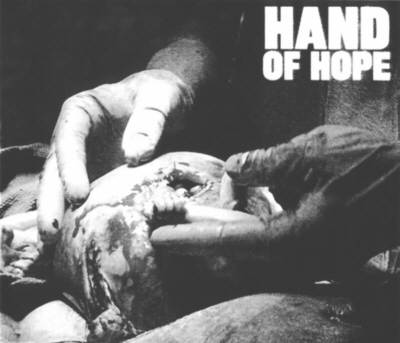
During surgery on little
Samuel, the little guy reached his tiny, but fully developed,
hand through the incision and firmly grasped the surgeon's
finger. The photograph captured the amazing event with perfect
clarity. The editors titled the picture, "Hand of Hope." Text
explaining the picture began, "The tiny hand of 21-week-old
fetus Samuel Alexander Arms emerges from the mother's uterus
to grasp the finger of Dr. Joseph Bruner as if thanking the
doctor for the gift of life. |
This picture is that of a 21-week-old unborn baby named Samuel
Alexander Armas, who is being operated on by a surgeon named Joseph
Bruner.
The baby was diagnosed with spina bifida and would not
survive if remand from the mothers womb.
Little Samuel's mother,
Julie Armas, is an obstetrics nurse in Atlanta. She knew of Dr.
Bruner's remarkable surgical procedure. Practicing at Vanderbilt
University Medical Center in Nashville, he performs these special
operations while the baby is still in the womb. In the procedure, a
C-section removes the uterus and the doctor makes a small incision
to operate on the baby.
That picture should be shown on every television newscast and run In
every newspaper in America.
It won't be.
Why? Because it is a
graphic reminder that growing in the womb is a baby' not a "glob of tissue," or "product of conception."
That
pre-born baby is a human being with all the emotions, will, and
personality of any human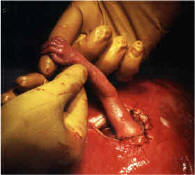 being. being.
That picture says it in a way that a
thousand words cannot.
Little Samuel's mother said they "wept for days" when the saw the
picture.
She said, "The photo reminds us my pregnancy is not about disability
or illness, it's about a little person." That's what it's
always been about. That's what the media elite wants us to forget.
And, that's why they don t want you to see the picture.
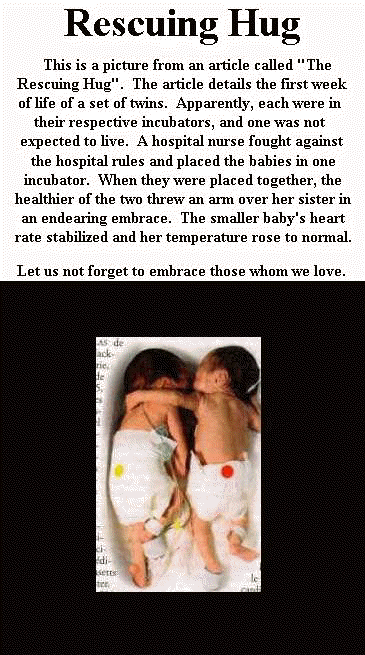
_____________________________________________________________________
MIAMI (AP) — A South Florida hospital plans to
release a premature baby today who doctors say spent less time in
the womb than any other surviving infant baby girl said to
have spent the shortest time in her mother's womb is to be released
from the hospital in Miami where she was born.
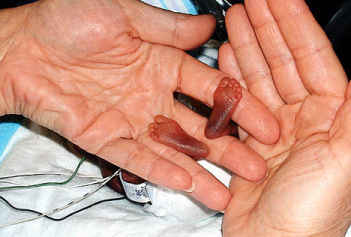
Amillia Taylor is believed to be the first baby to have survived
following a gestation period of less than 23 weeks. At the time of
her birth at the Baptist Children's Hospital last October, Amillia
measured 241 millimetres or 9.5 inches - no longer than a ballpoint
pen. She weighed just 284g or 10oz.
Amillia Sonja Taylor was delivered after just under
22 weeks of pregnancy. Full-term births occur after babies have
spent 37 to 40 weeks to in the womb.
Doctors who cared for the infant say Amillia is the
first baby known to survive after a gestation period of fewer than
23 weeks.
When Taylor was born on October 24th, she was
nine-and-a-half inches long and weighed less than ten ounces.
Amillia was delivered via C-section after attempts
to delay a premature delivery failed. However, she was breathing
without assistance at birth and even made several attempts to cry.
Doctors at the hospital attribute her survival to significant
technological advances in neo-natal care. Amillia's mother,
Sonja Taylor, said she was delighted at her daughter's continuing
progress.
'It was hard to imagine she would get this far. But
now she is beginning to look like a real baby. Even though she's
only four pounds (1.8kg) now, she's plump to me,' she said.
Doctors say the baby girl is now thriving and well enough to be
cared for by her parents at home. Even though she's
only four pounds (1.8kg) now, she's plump to me,' she said.
Doctors say the baby girl is now thriving and well enough to be
cared for by her parents at home.
'It may be that we need to reconsider our standard
for viability in light of Amillia's case,' a neonatalist at the
hospital said. The American Association of Pediatrics
indicates that babies born at less than 23 weeks of age and 400g in
weight are not considered viable. 'Over the years, the
technology that we have available to save these premature babies has
improved dramatically. Today, we can save babies that would have
never survived 10 years ago,' he said.
_____________________________________________________________________
Abortion in the
United States - Statistics
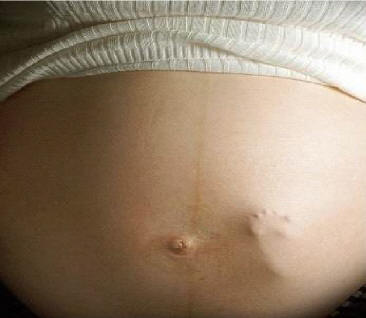
There have been over 43
million abortions since 1973.
·
The annual number of abortions went
from 744,600 in the first year of legalization, to a high of over 1.6 million in 1990.
In 1997, there were 1,312,990.
·
There were nearly
3,600 abortions per day in 2000, 149
per hour, about one
every 24 seconds.
· For
every 1,000 live births, there were 306 abortions in
1997.
· There
were more that 140,000 second and third trimester abortions in 2000.
· In
2000, more children died from abortion than
Americans died in the Revolutionary War, the Civil War,
World Wars I
and II, the Korean, Vietnam and Gulf Wars
combined.
· A
survey of women seeking abortions indicated that only 7% of women cited typical “hard cases” (rape,
incest, or some health concern with either the baby or the
mother) as the primary reason they were seeking abortion.
· A
June, 1999 Wirthlin Poll found that 62% of respondents support legal abortion in only three or fewer
circumstances: when the pregnancy results from rape or
incest, or when it threatens the life of the mother.
· At
an average cost of $372, the abortion business
is a $400 million a year industry.
· Nearly
half of all abortions are obtained by women who have already had at least one abortion. In
1994 and 1995, women who had already had 3 or more
abortions obtained 7%, or nearly 100,000, abortions each year.
|

